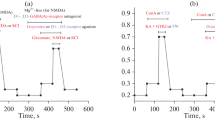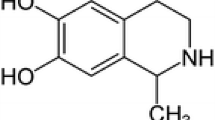Abstract
Developing neuronal populations undergo significant attrition by natural cell death. Dopaminergic neurons in the substantia nigra pars compacta undergo apoptosis during synaptogenesis. Following this time window, destruction of the anatomic target of dopaminergic neurons results in dopaminergic cell death but the morphology is no longer apoptotic. We describe ultrastructural changes that appear unique to dying embryonic dopaminergic neurons. In primary cultures of mesencephalon, death of dopaminergic neurons is triggered by activation of glutamate receptors sensitive to alpha-amino-3-hydroxy-5-methyl-4-isoxazolepropionic acid (AMPA), and differs ultrastructurally from both neuronal apoptosis or typical excitotoxicity. AMPA causes morphological changes selectively in dopaminergic neurons, without affecting other neurons in the same culture dishes. Two hours after the onset of treatment swelling of Golgi complexes is apparent. At 3 h, dopaminergic neurons display loss of membrane asymmetry (coinciding with commitment to die), as well as nuclear membrane invagination, irregular aggregation of chromatin, and mitochondrial swelling. Nuclear changes continue to worsen until loss of cytoplasmic structures and cell death begins to occur after 12 h. These changes are different from those described in neurons undergoing either apoptosis or excitotoxic death, but are similar to ultrastructural changes observed in spontaneous death of dopaminergic neurons in the natural mutant weaver mouse.
Similar content being viewed by others
References
Bayer SA, Wills KV, Triarhou LC, Ghetti B. Time of neuron origin and gradients of neurogenesis in midbrain dopaminergic neurons in the mouse. Exp Brain Res 1995; 105: 191–199.
Janec E, Burke RE. Naturally Occurring Cell Death during Postnatal Development of the Substantia Nigra Pars Compacta of Rat. Molecular Cellular Neuroscience 1993; 4(1): 30–35.
Jackson-Lewis V, Vila M, Djaldetti R, et al Developmental cell death in dopaminergic neurons of the substantia nigra of mice. J Comp Neurol 2000; 424(3): 476–488.
Oo TF, Burke RE. The time course of developmental cell death in phenotypically defined dopaminergic neurons of the substantia nigra. Brain Res Dev Brain Res 1997; 98(2): 191–196.
Tepper JM, Damlama M, Trent F. Postnatal changes in the distribution and morphology of rat substantia nigra dopaminergic neurons. Neuroscience 1997; 60(2): 469–477.
Lieb K, Andersen C, Lazarov N, et al. Pre- and postnatal development of dopaminergic neuron numbers in the male and female mouse midbrain. Brain Res Dev Brain Res 1996; 94: 37–43.
Blum M. A null mutation in TGFα leads to a reduction in midbrain dopaminergic neurons in the substantia nigra. Nat Neurosci 1998; 1: 374–377.
Coyle JT. Biochemical aspects of neurotransmission in the developing brain. Int Rev Neurobiol 1977; 20: 65–103.
Deshmukh M, Johnson EMJ. Programmed cell death in neurons: focus on the pathway of nerve growth factor deprivation-induced death of sympathetic neurons. J Pharmacol Exp Ther 1997; 51: 897–906.
Baker H, Joh TH, Reis DJ. Genetic control of number of midbrain dopaminergic neurons in inbred strains of mice: relationship to size and neuronal density of the striatum. Proc Natl Acad Sci USA 1980; 77(7): 4369–4373.
Macaya A, Munell F, Gubits RM, Burke RE. Apoptosis in substantia nigra following developmental striatal excitotoxic injury. Proc Natl Acad Sci USA 1994; 91(17): 8117–8121.
Marti MJ, James CJ, Oo TF, Kelly WJ, Burke RE. Early developmental destruction of terminals in the striatal target induces apoptosis in dopamine neurons of the substantia nigra. J Neurosci 1997; 17(6): 2030–2039.
Hattori T, McGeer PL. Synaptogenesis in the corpus striatum of infant rat. Exp Neurol 1973; 38(1): 70–9.
Groc L, Bezin L, Foster JA, et al. Lipid peroxidation-mediated oxidative stress and dopamine neuronal apoptosis in the substantia nigra during development. Neurochem Int 2001; 39(2): 127–133.
Groc L, Bezin L, Jiang H, Jackson TS, Levine RA. Bax, Bcl-2, and cyclin expression and apoptosis in rat substantia nigra during development. Neurosci Lett 2001; 306(3): 198–202.
Kelly WJ, Burke RE. Apoptotic neuron death in rat substantia nigra induced by striatal excitotoxic injury is developmentally dependent. Neurosci Lett 1996; 220(2): 85–88.
Marti J, Wills KV, Ghetti B, Bayer SA. The weaver gene has no effect on the generation patterns of mesencephalic dopaminergic neurons. Brain Res Dev Brain Res 2000; 122(2): 165–172.
Marti J, Wills KV, Ghetti B, Bayer SA. The weaver gene continues to target late-generated dopaminergic neurons in midbrain areas at P90. Brain Res Dev Brain Res 2000; 122(2): 173–181.
Bayer SA, Wills KV, Triarhou LC, Verina T, Thomas JD, Ghetti B. Selective vulnerability of late-generated dopaminergic neurons of the substantia nigra in weaver mutant mice. Proc Natl Acad Sci USA 1995; 92(20): 9137–9140.
Roffler-Tarlov S, Martin B, Graybiel AM, Kauer JS. Cell death in the midbrain of the murine mutation weaver. J Neurosci 1996; 16(5): 1819–1826.
Triarhou LC, Norton J, Ghetti B. Mesencephalic dopamine cell deficit involves areas A8, A9 and A10 in weaver mutant mice. Exp Brain Res 1988; 70(2): 256–265.
Oo TF, Blazeski R, Harrison SM, et al. Neuron death in the substantia nigra of weaver mouse occurs late in development and is not apoptotic. J Neurosci 1996; 16(19): 6134–6145.
de Erausquin GA, Hyrc K, Dorsey DA, et al. Nuclear translocation of nuclear transcription factor-kappa B by alpha-amino-3-hydroxy-5-methyl-4-isoxazolepropionic acid receptors leads to transcription of p53 and cell death in dopaminergic neurons. Mol Pharmacol 2003; 63(4): 784–790.
Dehmer T, Heneka MT, Sastre M, Dichgans J, Schulz JB. Protection by pioglitazone in the MPTP model of Parkinson’s disease correlates with I kappa B alpha induction and block of NF kappa B and iNOS activation. J Nerochem 2004; 88(2): 494–501.
Clarke PG. Developmental cell death: morphological diversity and multiple mechanisms. Anat Embryol (Berl) 1990; 181(3): 195–213.
Ishimaru MJ, Ikonomidou C, Tenkova TI, et al. Distinguishing excitotoxic from apoptotic neurodegeneration in the developing rat brain. J Comp Neurol 1999; 408(4): 461–476.
Dikranian K, Ishimaru MJ, Tenkova T. Apoptosis in the in vivo mammalian forebrain. Neurobiol Dis 2001; 8(3): 359–379.
Grilli M, Wright AG Jr, Hanbauer I. Characterization of [3H]dopamine uptake sites and [3H]cocaine recognition sites in primary cultures of mesencephalic neurons during in vitro development. J Neurochem 1991; 56(6): 2108–2115.
de Erausquin G, Brooker G, Costa E, Hanbauer I. Persistent AMPA receptor stimulation alters [Ca2+]i homeostasis in cultures of embryonic dopaminergic neurons. Brain Res Mol Brain Res 1994; 21(3–4): 303–311.
Isaacs KR, de Erausquin GA, Strauss KI, Jacobowitz DM, Hanbauer I. Differential effects of excitatory amino-acids on mesencephalic neurons expressing either calretinin or tyrosine hydroxylase in primary cultures of mesencephalic neurons. Brain Research, Molecul Brain Research 1996; 36(1): 114–126.
Martin LJ, Brambrink AM, Price AC. Neuronal death in newborn striatum after hypoxia-ischemia is necrosis and evolves with oxidative stress. Neurobiol. Dis. 2000; 7(3): 169–191.
Leist M, Jaattela M. Four deaths and a funeral: from caspases to alternative mechanisms. Nat Rev Mol Cell Biol 2001; 2(8): 589–598.
Stefanis L, Burke RE. Transneuronal degeneration in substantia nigra pars reticulata following striatal excitotoxic injury in adult rat: time-course, distribution, and morphology of cell death. Neuroscience 1996; 74: 997–1008.
Patil N, Cox DR, Bhat D, Faham M, Myers RM, Peterson AS. A potassium channel mutation in weaver mice implicates membrane excitability in granule cell differentiation. Nat Genet 1995; 11(2): 126–129.
Tong Y, Wei J, Zhang S. The weaver mutation changes the ion selectivity of the affected inwardly rectifying potassium channel GIRK2. FEBS Lett 1996; 390(1): 63–68.
Surmeier DJ, Mermelstein PG, Goldowitz D. The weaver mutation of GIRK2 results in a loss of inwardly rectifying K+ current in cerebellar granule cells. Proc Natl Acad Sci USA 1996; 93(20): 11191–11195.
Harkins AB, Dlouhy S, Ghetti B. Evidence of elevated intracellular calcium levels in weaver homozygote mice. J Physiol 2000; 524(Pt 2): 447–55.
Migheli A, Piva R, Wei J. Diverse cell death pathways result from a single missense mutation in weaver mouse. Am J Pathol 1997; 151(6): 1629–1638.
Author information
Authors and Affiliations
Corresponding author
Rights and permissions
About this article
Cite this article
Dorsey, D.A., Mascó, D.H., Dikranian, K. et al. Ultrastructural characterization of alpha-amino-3-hydroxy-5-methyl-4-isoxazolepropionic acid-induced cell death in embryonic dopaminergic neurons. Apoptosis 11, 535–544 (2006). https://doi.org/10.1007/s10495-006-5268-y
Published:
Issue Date:
DOI: https://doi.org/10.1007/s10495-006-5268-y




